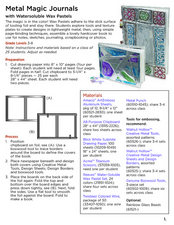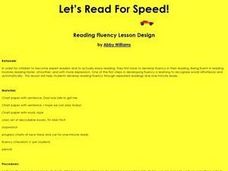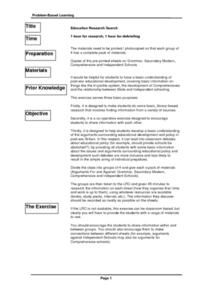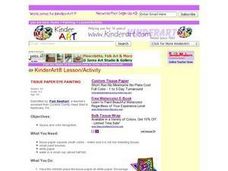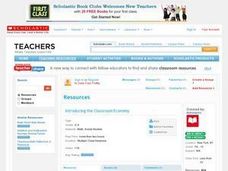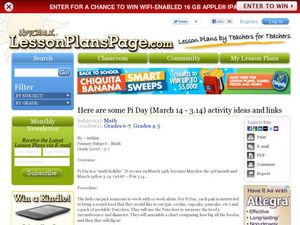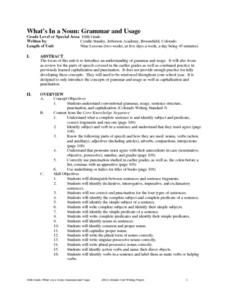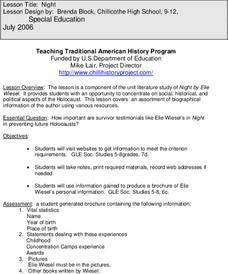Curated OER
The American Revolution: A War of Principle or Self-Interest?
Students examine the causes of the American Revolution. In this American Revolution lesson plan, students investigate a list of statements that reveal different perspectives on the causes of the war.
Curated OER
American Reactions to Fascist Aggression
Students consider the causes of World War II. In this origins of World War II lesson, students discuss American reactions to fascist aggression prior to the war.
Curated OER
Revolutions in Latin America: Bolivar, 1813-1814
High schoolers compare the leadership skills of Washington and Bolivar. In this Latin American history lesson, students read biographical information about George Washington and Simon Bolivar. High schoolers compare the men to better...
Curated OER
Metal Magic Journals
Create beautiful Metal Magic Journals with this lesson plan. They are great for keepsakes and gifts! It is also a fun way to learn about wax and metal.
Curated OER
Express Yourself
How do you make a story exciting? Teach young readers how to change your pitch, tone, and mood as you read. After modeling the various ways you can change your expression, have small pairs or groups work together to give it a shot!
Curated OER
Let's Read For Speed!
Explore reading for fluency and speed with your class. They discuss reading faster, smoother, and with more expression. Practice reading with fluency using one minute timed reads. They read "Tin Man Fix-It." and record how many words...
Curated OER
SAT Editing in Context Practice Test 01
Middle schoolers edit a draft of an essay, correct grammatical mistakes, and edit for unity and coherence. They answer 12 questions in 12 minutes in this SAT practice activity.
Curated OER
Education Research Search
Learners research post-World War II educational development and policy in the United Kingdom. In groups, they develop pro and con arguments about grammar, secondary modern, comprehensive, and independent schools. Collaborative work...
Curated OER
Tissue Paper Dye Painting
Use tissue paper squares to create collage art. Young artists discuss colors as they place and glue each piece of tissue on the paper. Tip: Cut out large basic shapes instead. Have the class create images using the tissue shapes (robots...
Curated OER
Making Paper: Recycled Art
The advent of paper has made a huge impact on society and we wouldn't be the same without it. This project allows learners to explore and create paper of their own using recycled materials. The how-to is all laid out, just follow the...
Curated OER
Sex Stereotypes in Society
Students analyze a collection of advertisements or photographs in a text or magazine and identify the stereotypes used or possible biases of the editors. They discuss how these stereotypes are formed, and the ways in which they impact...
Curated OER
An Illustrated Guide to the Late 1800's
Eleventh graders investigate the time of the late 1800's. They conduct research using a variety of resources that could include the internet. Students create an alphabetized encyclopedia of important historical people of the time period.
Curated OER
Introducing the Classroom Economy
Students discuss the definition of economics and study how current and historic societies have had economic systems. They determine necessary classroom jobs and attach ddaily or weekly salaries to those positions. Students are introduced...
Curated OER
"Pi" Day
Your class will complete research dealing with Pi and its value in mathematics, leading into a discovery lab to demonstrate Pi, how it is determined, and how it is used. In the end, learners eat PIE!
Curated OER
What's In a Noun: Grammar and Usage
Nine lessons in a grammar and usage unit provide endless opportunities for drill and practice. Topics include the four types of sentences, subject and predicates, nouns, verbs, adjectives, pronouns, adverbs and prepositions, conjunctions...
Curated OER
How Should Our Gardens Grow?
Students examine different types of land use by humans and evaluate the ways land is used in their local community. They also consider the environmental effects of the different types of land use. Students assume the role of community...
Curated OER
Those Busy, Buzz'n Worker Bees
Learners research information on worker bees. In this insect lesson, students review the body parts of insects and how bees find flowers. They discuss compound and simple eyes and the life cycle of a worker bee.
Curated OER
Marc Brown's Author Study: Arthur's Nose
Student's read Arthur's Nose and view the changes in Arthur's nose. In this Arthur lesson, students define difficult vocabulary, discuss choices and sing to the tune of Old MacDonald had a Farm. Students create a new nose for Arthur.
Curated OER
Night
Students read Night by Elie Wiesel, examine importance of survivor testimonials like Wiesel's in preventing future Holocausts, research biographical information online about Wiesel, and create author brochure including vital statistics,...
Curated OER
Me on the Map Lesson 2
Students analyze and interpret maps, globes and geographic information systems to define and identify cities, counties, states, countries and continents to create a booklet called me on the map. They also determine and calculate the...
Curated OER
First Degree Equations
Young scholars establish a solid competence in solving all types of equations and a solid understanding of how variables and equations can be utilitzed to solve real life problems.
Curated OER
Grade 5: Testing for Tessellations
Fifth graders use formal geometric language to describe polygons (and other shapes) that will tessellate the plane and those that will not. Students make generalizations about the characteristics of a polygon (or other shape) that will...
Curated OER
Eric Carle Collage
Learners gain appreciation for the work of Eric Carle. They speculate about a work of art, what materials, techniques and skills were used. They study Carle's work to determine how he did it and explore various water color techniques.
Curated OER
Suspension Bridge Drawing Lesson
Young scholars study the basic artistic styles of suspension bridges. They follow step-by-step instructions to draw a suspension bridge. Students discover volcabulary related to the architecture of bridges. They examine websites of bridges.





